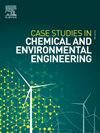Magnetically separable silica-chitosan hybrids for efficient phosphate adsorption in aqueous solution
Q1 Environmental Science
Case Studies in Chemical and Environmental Engineering
Pub Date : 2025-01-08
DOI:10.1016/j.cscee.2025.101100
引用次数: 0
Abstract
In the present study, magnetic silica-chitosan hybrid (NMP@SiO2/CPTMS/Chi) was synthesized via a convenient and green sol-gel technique under room temperature, and the material was used as a highly efficient magnetic adsorbent for the removal of phosphate ions in water. While the magnetic properties of NMP from iron enable the material to be quickly separated via magnetic separation, the abundant active sites from the chitosan made the hybrid exhibit high adsorption capacity for phosphate ions. At pH 6, the removal of phosphate ions followed the pseudo-second-order (PSO) kinetic model with the adsorption rate constant (k2) of 5.9 × 10-3 mg g−1 min−1 and obeyed the Langmuir isotherm model with a maximum adsorption capacity (qmax) of 15.06 mg g−1, outperforming most of the previously reported adsorbents. Stability tests and derivative thermogravimetry (DTG) analysis demonstrated that NMP@SiO2/CPTMS/Chi remained stable even under strongly acidic conditions and possessed high thermal stability, respectively. The synergistic combination of high adsorption capacity, acid stability, thermal stability, and facile magnetic separation renders NMP@SiO2/CPTMS/Chi a promising adsorbent for wastewater treatment and environmental remediation. Overall, this innovative material represents a significant advancement in phosphate removal, offering a sustainable and effective solution to address the global challenge of water pollution and protect aquatic ecosystems.

磁性可分离二氧化硅-壳聚糖复合物在水溶液中高效吸附磷酸盐
在室温条件下,采用简便、绿色的溶胶-凝胶技术合成了磁性二氧化硅-壳聚糖复合物(NMP@SiO2/CPTMS/Chi),并将其作为一种高效的磁性吸附剂用于去除水中的磷酸盐离子。从铁中提取的NMP的磁性能使材料能够通过磁分离快速分离,壳聚糖中丰富的活性位点使杂化物对磷酸盐离子表现出较高的吸附能力。在pH为6时,吸附速率常数k2为5.9 × 10-3 mg g−1 min−1,符合拟二级(PSO)动力学模型;最大吸附量qmax为15.06 mg g−1,符合Langmuir等温线模型,优于大多数已有报道的吸附剂。稳定性测试和导数热重(DTG)分析表明,NMP@SiO2/CPTMS/Chi在强酸性条件下仍保持稳定,具有较高的热稳定性。高吸附量、酸稳定性、热稳定性和易磁分离的协同组合使NMP@SiO2/CPTMS/Chi成为废水处理和环境修复的有前途的吸附剂。总的来说,这种创新材料代表了磷酸盐去除的重大进步,为解决水污染的全球挑战和保护水生生态系统提供了可持续和有效的解决方案。
本文章由计算机程序翻译,如有差异,请以英文原文为准。
求助全文
约1分钟内获得全文
求助全文
来源期刊

Case Studies in Chemical and Environmental Engineering
Engineering-Engineering (miscellaneous)
CiteScore
9.20
自引率
0.00%
发文量
103
审稿时长
40 days
 求助内容:
求助内容: 应助结果提醒方式:
应助结果提醒方式:


